Operation “Sea Lion” Invading England In 1940? [Part Two]
November 14, 2016 by crew
Last week, we embarked on an exploration of Operation Sea Lion, one of the most fascinating and debated invasions that never took place in World War II. In summary, Sea Lion was the proposed German invasion of England in the late summer of 1940.
Western Europe had just been crushed in a stunning German blitzkrieg, and carrying the offensive across the English Channel to topple the United Kingdom seemed, for a brief window, to at least pose a tantalizing (and terrifying) possibility.
Obviously, this invasion never took place. The German Luftwaffe (Air Force) failed to defeat the British Royal Air Force (RAF) in the epic Battle of Britain. Without air supremacy, German prospects in any cross-channel invasion were nil.
But what if the Germans had won the Battle of Britain? They came very close, after all, and such a victory could have opened the door for a “Sea Lion” invasion as we’re exploring here. In Part One of our series, we took a quick summary overview of this operation and previewed (in broad terms) some of its prospects.
Having set the stage, however, it’s now time to actually “give the go-code” and launch this hypothetical World War II invasion of southern England. Based on factors of the time, actual German plans, and the forces that would have been involved, this is a wargamer’s view how Sea Lion could have actually happened.
S-Day: September 15th, 1940
In the predawn darkness over the shores of Sussex and Kent, the roar of surf steadily fades beneath the massed drone of hundreds of German aircraft. The date is September 15th, 1940 ... set by the German High Command as “S-Day,” the code word for the opening of Operation Sea Lion. The invasion of England is on.
Our initial two battles will be fought along the east flank of the German invasion, near the vital port town of Folkestone. First, we’ll see German glider assault troops try to take Hawkinge, a badly-damaged RAF airfield just behind Folkestone, then watch 17th Infantry Division actually hit the beach just west of this critical objective.
With the RAF largely destroyed (or driven back to airfields in the Midlands and Scotland), and their radar warning network reduced to wreckage, the British can do little to intercept the initial phases of this invasion, which is delivered not from the sea...but from the air.
One of the initial targets the Germans have selected for their airborne drops is Hawkinge Airfield, just a few miles inland from Folkestone. A glider assault force of 7th Airborne Division has been detailed with taking this former RAF field, so dozens of waiting Junkers Ju-52 transport planes can bring in larger elements of German light infantry.
Hawkinge has had an RAF airfield since World War I, and served as an important staging point during the invasion of France. During the Battle of Britain, it was eventually put out of action by heavy Luftwaffe attacks, but now it may serve as a “staging airfield” for the enemy.
German airborne units fell into three broad categories. These were “Fallschirmjäger” paratroopers, “Luftlande-Sturm” (air landing assault) glider troops, and divisions of light infantry who were simply shuttled into captured enemy airfields via waves of Ju-52 transports. Of course, those airfields (like Hawkinge) had to be taken first.
Of course, Hawkinge airfield was just one target the Germans have struck from the air on S-Day. By 05:00 hours, paratroopers of Kampfgruppe “Meindl” (containing the bulk of Fallschirmjäger Regiment 1, or “FJR 1”) have also landed at Hythe and secured crossings over the Royal Military Canal.
Taking all the bridges over this canal is crucial, since it now seals off the British ground troops holding the beaches along the Romney Marsh, the main landing zone of XIII Corps.
Meanwhile, Fallschirmjäger Regiment 2 (FJR 2) has landed north of Postling, holding crossroads against any British counterattack from the north. FJR 3 has been detailed to secure the western flank against any British counterattack mounted from Sussex, detaching one battalion to take Lympe airfield, to be used to insert 22nd Air Landing Division.
Throughout the towns and villages of Kent, fighting is heavy and confused throughout these morning hours. The major British unit in the area is 1st London Division (XII Corps, Eastern Command), a Territorial unit NOT sent to France. Thus, they never lost most of their heavy equipment at Dunkirk and so make a good account of themselves.
One particular example is along the Royal Military Canal, where Kampfgruppe “Meindl” of FJR 1 actually fails to take two bridges, bloodily repelled by the London Irish Rifles (1st London Infantry Brigade). An emergency call is made to a German “kampfgeschwader” bomber group, however, who destroys the two bridges instead.
Yet while this air strike secures the Romney-Folkestone beaches from potential British counterattack or reserves, it also means these bridges will not be available to facilitate any subsequent German breakout once XIII Corps hits the beach (17th and 35th Infantry Divisions, already landing on the assault beaches).
Almost everywhere else, however, German success is swift. Although suffering high casualties in places, objectives like Lympe airfield, Postling, and Paddington are quickly secured by fallschirmjäger paratroopers and glider assault troops. By 13:00 hours, lead elements of 22nd Air Landing Division are being deployed into the bridgehead.
And as we’ve seen in our Battlegroup skirmish game, the German detachment assigned to take Hawkinge field has been successful. Although damaged in previous weeks, engineers will soon have this field in service. Two squadrons of Messerschmitt Bf-109 fighters will be based here, part of the vital air cover for further stages of the invasion.
Beaches Of Folkestone
While glider assault troops and fallschirmjäger paratroopers were hitting vital targets overlooking the invasion beaches, the first waves of German seaborne infantry were hitting the beaches themselves. Among these, the 17th Infantry Division (XIII Corps) landed along the “Romney Marsh,” extending west from the port town of Folkestone.
As wargamers, the first thing we have to understand about these Sea Lion “beach landings” is that they wouldn’t have resembled anything at Normandy. Folkestone was no Omaha or Sword beach. There Germans have not taken two years to build a 5000-ship invasion armada, and the British have nothing like Hitler’s “Atlantic Wall.”
Rather, this is a very rushed and improvised landing force hitting a rushed and improvised beach defence. True, relics of Britain’s coastal defences can be visited even today, just bear in mind that almost all of this was built in the winter and spring of 1940-41. In September of 1940, we’re just looking at some dugouts, mines, and barbed wire.
Nor do most credible historians put must stock in fantastical ideas of a secret petrol-pumping system that would have lit the English Channel on fire. Such an idea didn’t work for the Israelis in 1973 in the Suez Canal, a body of water 1/100 the size, without currents or surf, and after six years of preparation. It wouldn’t have worked here.
Records of Churchill’s order to use mustard gas on German invasion troops are a little more credible, but not in the early fall of 1940. First of all, sufficient stocks of such chemical weapons wouldn’t have been available since they were destroyed by treaty after World War I. Also, civilians had not been evacuated from these coastal areas.
The simple fact is that British coastal defences in September 1940 were thin and brittle. The coastline open to possible attack was twice the length of the French and Belgian borders the Germans had just overrun, and the British now had to hold it with one-quarter the troops and one-tenth the heavy equipment.
That said, the Germans would have had the devil’s own job trying to cross the Channel in their “invasion fleet” of converted fishing boats and river barges. Even if they owned the sky, they would have taken terrible losses just getting out of the water. On both sides, this would have been “Normandy: Amateur Hour.”
Again, German tactical air power offers the only real hope such landings could have been carried off. However, the Luftwaffe would have been tasked not only with supporting the infantry, but also protecting the invasion corridor from the Royal Navy, and protecting the airborne landings.
How well could they have accomplished all three missions...at once?
The Germans had a few surprises ready for the beaches, though. Among these were the “tauchpanzers,” tanks modified to travel for a short distance underwater and crawl up onto the beaches. Four battalions (160 tanks, mostly PzKpfw-III variants) were ready for S-Day, designated battalions “A” through “D”.
In our Panzer Leader game, the Germans took predictably heavy losses trying to get ashore. Only Luftwaffe airstrikes (and off-board artillery strikes called in from huge 12” and 15” guns in Calais) were able to suppress British coastal artillery emplacements.
Once a foothold was established, however, the game was up. Outnumbered British regulars, territorial rifle units, and even Home Guards were no match for a “First Wave” German infantry division like the 17th.
Folkestone was soon outflanked and taken, opening a port for heavier German units to land on S+1, including panzer formations.
What do you think of our Sea Lion scenarios so far? The Germans may have managed a lodgement here, but this is just a small part of the invasion front, and the campaign has a long way to go.
Keep the conversation going in the comments below, and come back next week to see how far “Seelöwe” will actually go.
If you would like to write for Beasts of War then please contact us at [email protected] for more information!
"...it’s now time to actually “give the go-code” and launch this hypothetical World War II invasion of southern England"
Supported by (Turn Off)
Supported by (Turn Off)
"The simple fact is that British coastal defences in September 1940 were thin and brittle..."
Supported by (Turn Off)































![TerrainFest 2024 Begins! Build Terrain With OnTableTop & Win A £300 Prize! [Extended!]](https://images.beastsofwar.com/2024/10/TerrainFEST-2024-Social-Media-Post-Square-225-127.jpg)









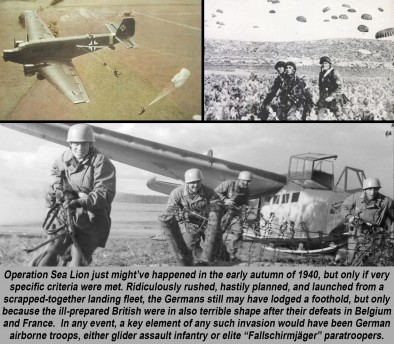

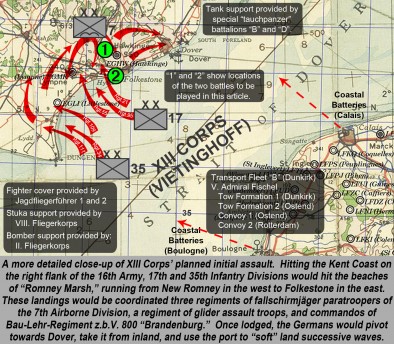
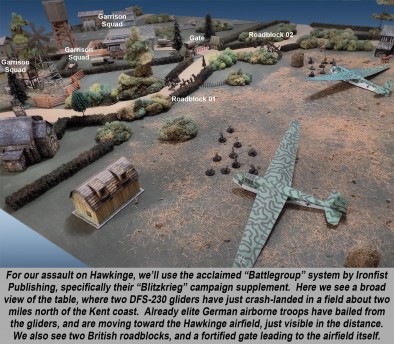
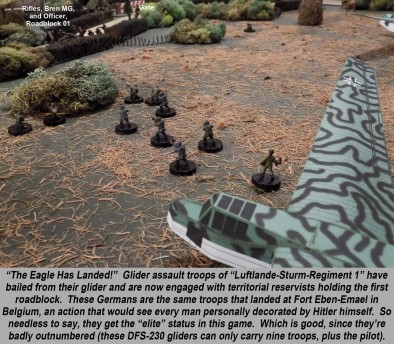
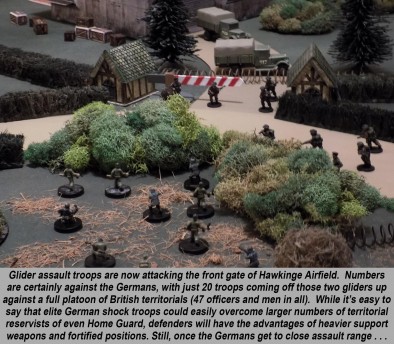

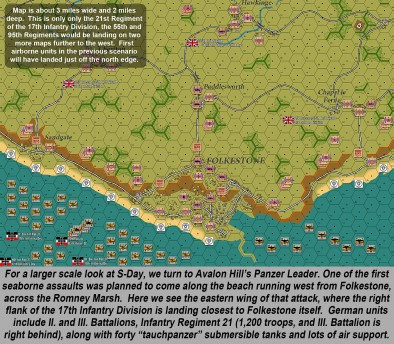

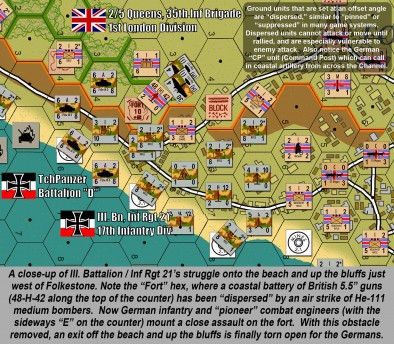



































Great read just as last week! 🙂
Have you taken into account random factors such as weather, bad comms, current etc?
Great questions, @neves1789 – Have we taken into account … 1) Weather – in a larger sense, no. I’m taking the assumption that the Germans simply wouldn’t go if the weather wasn’t at least initially favorable. As we see with “Adlertag” during the Battle of Britain, the Germans (like almost anyone) simply postpone an operation if the weather’s not good. Since we’re showing Sea Lion launching, we’re assuming the weather is good on September 15 (or whenever S-Day is to take place). D-Day was originally slated for June 5, 1944. The weather wasn’t great, they pushed it back a day.… Read more »
Wow! That was almost another article on its own!
Well, I’ve always appreciated it when people post in the comments it gives me a chance to “fill in the gaps” I wasn’t able to cover in the article itself. And you should see some of the monolithic “walls of text” @jamesevans140 and I have been trading in Article 01’s thread. 😀
Just finished reading a book about so this made great reading
Thanks very much, @wolfkind. I hope the articles measure up! 😀
Now, that’s exactly how I put the puzzles together in my head after last week’s deliberations in pt1. I do like the fact that so many various factors had been put into the thing including this table connected with the beach landings. Yet, I am intrigued, since I am not really aware of how the British OOB looked like at that time, where was the force that would presumably be used to push sie Germans back to the sea as for example would have happened in Normandy a few years back if only some people would listen to Rommel. I… Read more »
Thanks, @yavasa – Glad you liked the article, and how we handled the beach landings. Now we also take another look at the beach landings in Part 3 – through miniatures instead of hexes-and-counters – so we can look at this from different angles. It also allows us to explore possible problems and ramifications of delayed / weakened landings due to Royal Navy interference (a factor that I feel would have been greatly mitigated, but never completely eliminated, via our presumed Luftwaffe air supremacy). As far as British reserves and armored counterattacks go: We do have some pretty detailed information… Read more »
Waiting for part 3 and 4 🙂 @oriskany
😀 That, and we’ll have the support thread up in the historical forums some time this week.
Well made, Sir! Very well.
Unfortunately my English is missing the right words to express what I have in mind…
Thanks very much, @setesch . Well, your English is a helluva lot better than my German, I just hope that “what you have in mind” remains good overall. 😀
It is indeed 😉
😀
@Oriskany : So not only do the Germans have to win the Battle of Britain, but they also have to make sure that they don’t damage the airfields they need too badly. However in doing so they might have given the British enough breathing room to survive. This was a problem in the battle at The Hague too as the damaged air fields prevented them from landing as the troops they might have needed. I think the Germans would have used ‘Hook of Holland’ instead of Rotterdam for their staging area. It’s closer to the UK and it has had… Read more »
Thanks, @limburger – Indeed, from the beginning we’ve maintained sort of a two-sided, almost self-contradictory stance on the Battle of Britain and the state of the RAF in any reasonable discussion of Sea Lion possibilities in 1940. On the one hand, yes, the Germans have to win, and you’re correct, you destroy an air force not bey shooting down all their aircraft, but by destroying their infrastructure, including (but not limited to) surfaced runways. On the other hand, even a complete German “victory” here doesn’t destroy the RAF in total. As said in previous threads, limited range of Luftwaffe Bf109… Read more »
I don’t know enough either, but the Wiki says that to the Germans it was an important harbor location. They probably would have used both. Rotterdam would be used for getting as many ships as possible and loading the lot, HvH would be the starting point of the actual attempt to cross, which kind of makes sense as that would have meant less time spent on open water. At that time Rotterdam harbour probably wouldn’t have been as close to the sea as it is these days, so Hoek van Holland might have been a more practical choice. One thing… Read more »
Looking at the map (I’ve never traveled there myself) I’d agree with your comparisons of Rotterdam and Hoes van Holland. The damage caused by the Rotterdam bombing earlier in the summer also has to be considered.
Enjoying this series. As a Canadian I’m looking forward to parts 3 & 4.
Awesome, @littlejon . I think you’re going to like Part 4 in particular. 😀
Not being a military history buff myself, I have to say my favorite part of this article… In fact all the articles… is actually how you write them. You make your language vivid withou being outrageous or yellow journalism like. You paint a very vivid picture with your words combined with the pictures and the maps and I actually think I understand some military tactics! 🙂
Yellow journalism? I’d have to be a journalist, which I would never claim to be. Just a gamer who writes articles. 🙂 The truth is “purple prose” takes up word count, which is limited in these articles. Honestly, I never have “room” to be “gushy.” Just another case of “better design through constraints.” (with the credit for the constraints going to @brennon and the BoW team, not myself). 😀
Interesting landing @oriskany did you choose the marshes to confuse the brits or is that part of the documented landings possibilities? Not any documented uses of the tauchpanzer in other battles?
P S I love postlethwaite’s artwork.
http://www.wehrmacht-history.com/heer/amphibious-vehicles/panzer-iv-als-tauchpanzer.htm
Thanks, @zorg – The beaches extending from Folkestone, westward to New Romney are the indeed the “prime candidate” landing beaches for 17th Infantry and 55th Infantry Divisions (combined to make the leading edge of XIII Corps / Sixteenth Army). Towns like Sandgate, Hythe, Dymchurch, and New Romney would have been taken, followed by a pivot eastward to take Folkestone itself from the side. I believe in this way the Germans hoped to capture Folkestone and other ports across the invasion sector via inland approaches, and then use the port facilities to “soft land” heavier formations like second-wave panzer divisions. Tauchpanzer… Read more »
Aieee . . . that should read “17th and 35th Infantry Divisions.” Sorry about that. And yes, Postlethwaite’s artwork is great and deservedly well-known, so I wanted to make sure I gave proper credit. 😀
similar to when the Canadians tried to take Dieppe.
I’m only 50% well-read or so on Dieppe, but yes, I’m pretty sure taking the port was part of the plan, at least temporarily. Of course Dieppe wasn’t supposed to be any kind of a permanent invasion. That whole operation has always baffled me. Too big to be a raid, too small to be an assault. You can’t even claim political expediency (i.e., to show Stalin that the Western Allies were doing something). If it had been a successful “dress rehearsal,” all it really does is show the Germans your tactics, methodology, and overall plan of attack. British and even… Read more »
yes they were lucky more people never died in the raid didn’t a unit get wiped out a week or two before on a practise landing when a E-boat squad attacked the landing boats sinking most of them.
I honestly don’t know, @zorg – I’d have to read up on it. 😀
One of the points I have seen debated on and off is whether or not Hitler chose toallow many of the allied forces to escape at Dunkirk because he wanted Britain to sign a treaty or surrender of some sort. If the plan was always for an invasion would it make more sense that the Germans would have pushed harder at Dunkirk and even less Allied veteran infantry would have been available for the period of sea Lion?
Don’t forget… Those Panzers heading for Dunkirk had to stop for a while… things needed to catch up.
Thanks, @jsaxty – and I agree with @piers . It bears noting that the infamous “Panzers in front of Dunkirk” is really only two divisions, 5th and 7th of Hermann Hoth’s XV Motorised Corps, and I’m not sure, but I believe Rommel’s 7th was racing further west. True, Reinhardt’s XLI Motorised Corps (6th and 8th Panzer Divisions) were rolling up the other side of the Dunkirk Pocket through Boulogne and Calais, but I don’t think they were really in position yet, to say nothing of the infantry divisions Piers mentions. One view is that Hitler was watching the campaign very… Read more »
it is documented that Adolf got the figures wrong about tank figures.
Great article and ‘what if’ gaming report. If the Germans had got a beachhead established at that early stage of the war I believe it would have been an incredibly bitter and hard fought occupation. Assuming Hitler concentrated on subduing Britain I don’t think things would have gone in the Allies favour and the casualties would have been horrendous. Thank goodness this never eventuated, as the British mainland would likely have been as devastated as the most heavily fought over European countries. By the time Allied forces took it back, which undoubtedly would have happened in time, Britain would not… Read more »
@spaced2020 – I couldn’t agree more. On the one hand, I’ve been maintaining on previous threads that I don’t think Britain was quite as politically stable as many remember, given our scenario of a British defeat in the Battle of Britain. To a large extent, it was this historical victory that put real iron behind Churchill’s words of “We will fight them on the beaches,” etc. Until that victory (which HASN’T come in this alternate timeline), there was a pretty sizable faction of Parliament who thought the Germans might really be unbeatable and it was unwise to further antagonize them.… Read more »
yup would have been as bad as the marines taking japan I think. @oriskany
Assuming the British government stands . . . yes. We must remember that in this scenario, they would not have been electrified by success in the Battle of Britain, and not comforted by the promise of American aid. By and large the Americans were not betting on the UK until after the Battle of Britain was a success. In this scenario it must be regarded as yet another colossal defeat by a seemingly “invincible” German war machine.
It staggers the mind to conceive what direction the war would have gone during the early forties if Britain had succumbed to a successful German invasion/occupation. Who would have coordinated a successful retaliation against the Nazi warmachine in North Africa? Would Britain have been able to undertake the Anglo–Iraqi or Syria-Lebanon campaigns? How would this have gone on to have affected the timing and available resources for Operation Barbarossa? Who would have consolidated and commanded the remaining Commonwealth forces? The Battle of Britain was such a pivotal point in the war. Fascinating stuff. Thanks again James for taking the time… Read more »
Thanks very much, @spaced2020 – Indeed the alternate timelines very very unpredictable once you make a change as significant as a defeat or negotiated peace with the UK. North Africa might not have happened at all. Italian 10th Army would have still invaded Egypt in September 1940, the WDF still would have defeated them, but without orders from London. I don’t think we would have seen an “Operation Compass” counterattack in December 1940. We go over this a little in The Desert War Article Series, Part Two: http://www.beastsofwar.com/battlegroup/desert-war-gaming-ww2-part-two/ We also have to look at how Britain’s exit from the war… Read more »
when has the government stopped a fight don’t forget half of the battles in the UK were against the government or king of the time. @oriskany
I would agree that popular resistance might have smoldered on in the wake of a potential government collapse. But to actually wage a modern war, you need an army, factories, billions of dollars, infrastructure, an officer corps with 30-40 years’ experience . . . in other words, you need a government.
You can’t run “real” war by Kickstarter. 😀
true but would have been a hell of a gorilla fight to control the country for a while.
Another excellent, well researched and thought out article. Looking forward to III & IV
Joe90
What he said, the amount of research you put in to the articles are impressive
Thanks very much, @joeninety and @rasmus . Although, of course, in an “alternate history” project like this, research can only get you so far. Sooner or later you have to make a few guesses and take a leap. Which of course is what makes it so much fun. 😀
Thanks again. 😀
@oriskany A both fascinating and chilling read! Will you follow this article up with an article about a combined Nazi and Japanese invasion of the USA?
Thanks, @davebpg . 😀 Eh … believe it or not I have done some pretty serious work kind of along the lines you suggest. Frankly, I don’t there’s any kind of realistic scenario that puts German or Japanese occupation forces in the US (not really a fan of Man in the High Castle, etc). There are several plans out there, most of these are ironically concocted by the American press to frighten citizens into buying war bonds, etc. The closest I’ve seen to any kind of German invasion of North America is Operation Mammoth (Mammut) – which basically entails an… Read more »
Many possible scenarios to consider. What’s certain is that had the uk fallen, the government and royal family would almost have certainly escaped to Canada. I doubt the surrender of the uk, and I guess Ireland, would have caused Canada to capitulate as well. I would imagine the uk colonies would have done what they good against their respective invaders, Indians and Australians against Japan for example. A combined mainland invasion of Mexico by the Nazis and the Japanese would have given the axis powers a “soft under belly” of their own to launch attacks against mainland USA. Shame Trump… Read more »
I agree about the prospects of the UK Commonwealth / Empire. I think Churchill said in a speech: “And even if, which I do not for a moment believe, this island or a large part of it, were subjugated and starving, the British Empire, armed and guarded by the British Fleet, should carry on the struggle until, in God’s own time, the New World steps forward to the liberation of the Earth.” Translated: “Even if Britain falls, the Commonwealth will continue to fight until America gets it ass in gear.” 😀 There were indeed plans for move big parts of… Read more »
Now that is news to me – the Edward VIII thing – and just the kind of crazy thing you’d expect the Nazis to think would work.
I hear you, @spaced2020 – it sounds pretty absurd. Like I said, I have no idea how concrete these discussions / plans were. I think part of it stems from a strange view many in the Nazi leadership held for Britain. There are just certain things that HAVE to be.
“Even if we conquer them, they’ll need to have a Royal on the throne, right? England ALWAYS has a king or queen.” ??? Right??
@oriskany another interesting article, on a side note it remined me just how unequipped the British were in 1939, as i have seen all the records in the Imperial War Museum that showed that the all the servicable weapons etc that were held in the IWM from the first world war were requisitioned by the British Army in 1939. Most being then left in France. So I wonder just how well equipped the Soldiers post Dunkirk actually were.
Couldn’t agree more, @commodorerob. In references I keep seeing the BEF described as “the most modern and mobile” part of the British Army, and while 240,000 British troops may have been evacuated from Dunkirk, almost all their equipment and vehicles had to be left behind. So while the British have enough manpower to field 20-30 divisions, there isn’t that much with which to equip them. The basic model that seems the most realistic is for the better-equipped divisions (the ones that hadn’t been sent over to France and Belgium with the BEF) to give up some of their equipment to… Read more »
Still one man and a pointy stick can cause a lot of irritation… They don’t like it up em you know 😉
😀 “They don’t like it up em you know”
Ehh . . . the less I know the better. 😀
Once again love your info, Maps and Deployment of British forces looks spot on.
Could we have held at that time ?????
Man with twig in helmet, “Wrong kind of cammo for built up areas”.
Thanks, @nosbigdamus – Later this week I’ll be starting the parallel “support thread” in the historical forums. In this thread I’ll be able to post some of my sources, including a great map that shows where the British divisions and brigades were deployed in September 1940. I also have some pretty detailed maps of German invasion plans (especially in the New Romney-Folkestone area) I’ll be able to post. Hopefully the community will find this stuff interesting. That reminds me of Anthony Hopkins in A Bridge Too Far. 😀 When they get to Arnhem, he mutters . . .”I just realized… Read more »
Really like this idea, exited for the next one, number 3, you do put out shockingly good stuff.
Thanks very much, @nosbigdamus . 😀
Yes wagons roll. Great second installment @oriskany. I think your simulation of lodgement worked out well. Some parts went to plan, a few things went better than planned and finally the things that unexpectedly went wrong causing issues for the next stage. This is the striped down script for historical landings, so your close to the mark. The burning of the channel by secret pumping stations was one of those stories going around and becoming myth. Like most myths there is some truth in them. The truth is there were pumping stations, many of them all over southern England. They… Read more »
Good afternoon, @jamesevans140 – Great post. 😀 Let me try to reply point by point … I think your simulation of lodgement worked out well. Some parts went to plan, a few things went better than planned and finally the things that unexpectedly went wrong … At the risk of overgeneralizing, I’m of the opinion that both sides in a September 1940 scenario would have been woefully under-prepared and ill-equipped for their respective missions. This is a recipe for total chaos. But the side that usually manages to pull the win out of chaos is the side that has the… Read more »
Building up nicely, can’t wait to see if I should speak German in your version.
Ja, wir müssen Deutsch sprechen!
Yep I had m my own invasion. It starred with ‘sorry for not phoning ahead but…’ so total surprise achieved, then came the mad rush to get some U.S.troops I am painting at the moment to much higher ground. It was a good day with the usual they came, they saw, the trashed the place. 🙂 The burning of the channel idea I believe comes from an idea dating back to the age of sail of burning the port waters. I read references to the idea but not of its defensive use, there are several references to its offensive use… Read more »
Indeed, @jamesevans140 – good ole’ fireships. Between the ships they burned to fend off the Spanish Armada, sinking ships in ports to deny Germans use of the facilities (thanks again for that idea @yavasa ), sinking ships as breakwaters for the Mulberry harbours, and crashing destroyers into German dry docks during the St. Nazaire raid, it seems the Royal Navy likes blowing up their own ships almost as much as the enemy’s. 😀
Stunning. Really enjoying the ‘what if’. I live in a town called Ramsgate in Kent and not far (1 mile) from RAF Manston (which was my last posting). I have a particular fascination with Operation Sealion as both of my grandparents and uncles aunties etc., lived in Ramsgate throughout the Second World War. I used to listen with fascination of the stories they told me and how, especially in the early stages of the war, it affected their lives. My grandfather worked for the railway and did up to retirement but was in a reserved occupation so wasn’t allowed to… Read more »
Apologies, just shown my Dad this and he has corrected me. Him and his mate found the unspent round in his front garden. But a lone fighter unloaded a whole load of ammo into his sisters bedroom, while she was still in bed. Apparently she woke up after the event covered in plaster. I stand corrected 🙂
The round blew up when they messed with it? Man, it must have been one of the 2.0 cm (MG FF) cannon rounds, I’m guessing incendiary or explosive (most pilots liked their cannons armed with a varying mix of ammunition types). We’ve heard from a couple people now who live right around these proposed invasion zones. So (a) I apologize again if we blow up anyone’s house. 🙂 And on a more serious note, (b) I hope this comes across with due respect . . . to both sides . . . because YES, we have people from both nations… Read more »
First of all no offence taken. I’m well aware from my grandfather and uncles that the Home Guard had many shortcomings. That one rifle I mentioned before, my Grandfather told me that they used to take it in turns to carry it. One day they heard a load bang in the booking hall and raced up there to see what had happened and the booking clerk had put one up lent it against his desk, it fell over and the round went off. All my granddad could think about was that they were now down to 9 rounds. He eventually… Read more »
Had a read of your comments and the recollection of your relatives experiences. Always interesting to hear how folks lived during those times, so thanks for sharing.
Good afternoon @minty45 and @spaced2020 – “He eventually became platoon sergeant and was issued with a Thompson. He said he felt like an American gangster lol.” The Thompson M1928 / M1A1 is indeed a beautiful weapon. Expensive to produce in military quantities, though especially once EVERYONE in the western world wanted one. I think this is the reason they started with the M3 “grease gun” eventually, a much, mcuh cheaper SMG. Even the American economy can’t make Thompsons for everyone who wanted one 1940-45. “One thing you don’t take into account though is the local population. Actually, we just haven’t… Read more »
Good evening @oriskany. The first I read of sinking ships in the harbour was one of the wars against Holland in the age of sail. The British had sunk ships and other obstacles in the Thames river. The Dutch sent a raid on London and got snagged on sunken ships becoming easy prey. The British isles have a very long history of being invaded, some successful and others not. So they are quite experienced at dealing with unwanted guests. The RN have long used the Home port strategy. This is basically take the war to the enemy’s home port to… Read more »
The British isles have a very long history of being invaded, some successful and others not. So they are quite experienced at dealing with unwanted guests. Indeed, there have been more successful invasions of the British Isles than unsuccessful invasions. Caesar failed, the Spanish failed. I guess with the Battle of Britain, you could say Hitler tried and failed (depending on your definition of what an attempted invasion looks like). But then we have William the Conqueror who succeeded, Claudius who succeeded, the Saxons who succeeded, the Vikings who succeeded . . . And none of these people had huge… Read more »
I agree @oriskany, I believe it is S+4 to 8 weeks things welcome interesting. In this period is here the RN has recalled the Navy to defend the Home Isle, with the possible exception of the Mediterranean Fleet as the Suez must remain open. Towards the end of this period the Commonwealth will begin to respond. Here Canada would be a big responder with its army and navy, admittedly a smaller and not as powerful as it would become later. Egypt and India are more interesting, sensing to overlord on it’s knees may seem opportunistic revolts to grab independence. India… Read more »
Now that’s a “domino” effect I hadn’t considered, @jamesevans140 , some of the British colonies / dominions taking their chance to break away. The Germans were working in Iraq, trying to start trouble there. Palestine / Transjordan was already experiencing turbulence . . .
Interesting isn’t it @oriskany. As you know I like to look at a situation from minor tactics to grand strategy. The penny dropped when I started to consider the response from the commonwealth. First question was the condition of members and there ability to respond. This posed the question would they respond. Then what impact would Operation Sea Lion have on countries that were technically neutral but sitting on the fence, so to speak. As an example Henry Ford was using his influence to keep the US either neutral or on the German’s side of the fence. The underlying reason… Read more »
Well, @jamesevans140 – I have finally just submitted Part Five to Beasts of War, so at least for my money they verdict is in. 🙂 Definitely agree about the lack of an American public opinion backing for the UK during this time. The opinions, writings, and communications of Joseph P. Kennedy (US Ambassador in London) certainly weren’t helping. I think opinion really started to change over here after the British won the Battle of Britain. But if they LOSE the Battle of Britain. I certainly think the Italians would have been even more bold in their moves of August –… Read more »
J.P.K is an interesting biography in itself. Anti British to the extreme. Most comments sent back to F.D.R was tainted by this would view to the point of untruths. He quickly felt out of favour when F.D.R. sent one of his Skulls friends as part of his secret personal spy network to London for a second opinion and uncovered a different story. The main thing F.D.R was looking for was something that he called backbone. That J.P.K had been reporting it was not there, when it did. However this is politics, which I normally do not study. The politics of… Read more »
Good morning, @jamesevans140 – JPK’s attitude toward the British is rather complex. A big part of why he felt the British would fold is their previous policies of appeasement. Of course what we have to remember is that he SUPPORTED this policy all through its implementation. He was definitely NOT a fan of Churchill even before he became Prime Minister, possibly because of JPK’s cherished status in London “high society” which Churchill often snubbed. There is also the possibility that Churchill, with his long heritage going back to the his ancestor the Duke of Marlboro (and perhaps earlier for all… Read more »
@oriskany I believe the politics the day is perhaps more complicated than today’s. At the least it has more layers and agendas than the present. World War is a complicated thing to begin with. Normally I try to study military history in a void without politics however the politics and strategies of 1940 do require some consideration as they are both in flux and are interdependent. I read a book called Warlords a few years ago and since then has it been made into a 4 part doco. It’s focus is on the interplay between FDR and Churchill as well… Read more »
@jamesevans140 –
I would normally agree about leaving politics of the day off the gaming table. And in truth, whether or not Winston is in office really doesn’t effect our Panzer Leader or Battlegroup games. I’m just including it in the narrative because I honestly feel its one of the least UN-likely paths to ultimate German victory. I certainly don’t expect them to push through the streets of London, up through the Midlands, and drive panzer spearheads all the way up into the Scottish Highlands. 🙁